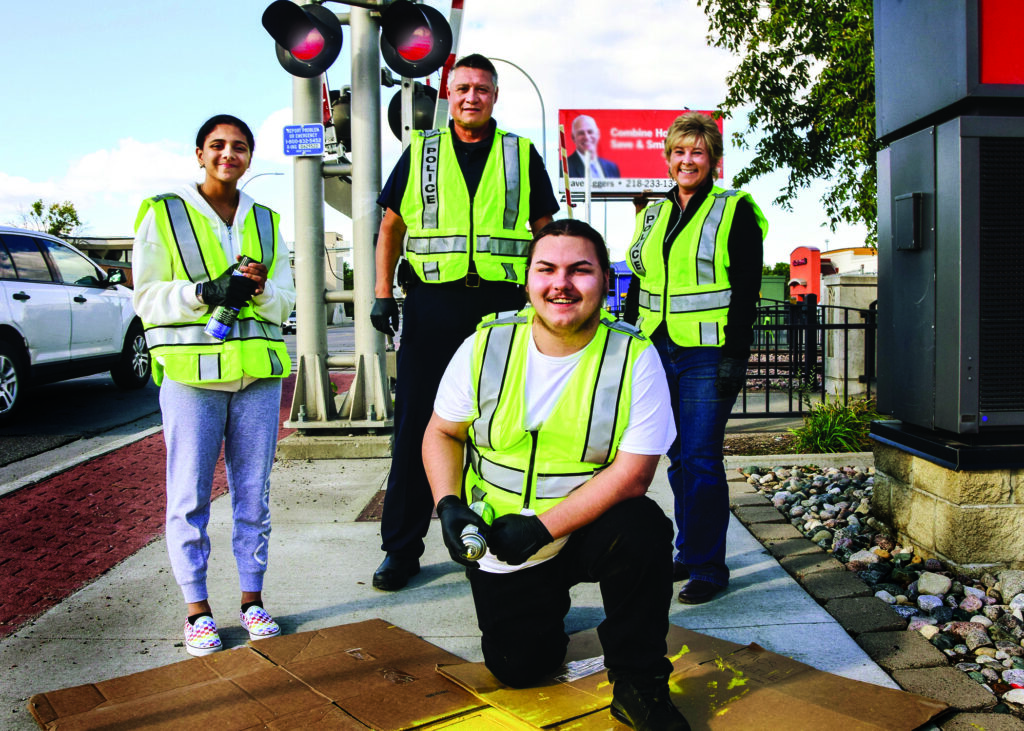
David Smith sprays a warning next to a downtown rail crossing — “See tracks? Think trains!” It’s part of Rail Safety Week in Moorhead. Watching are Dabria Robinson, Moorhead Police Department youth services coordinator Louis Ochoa Jr., and community policing coordinator Leann Wallin. (Photo/Russ Hanson.)
Nancy Edmonds Hanson
The warning that teens are chalking on downtown sidewalks seems obvious: When you see railroad tracks, beware of oncoming trains.
But that simple note of caution belies the danger posed by those tracks and the trains that ride them. That’s the thinking behind the city of Moorhead designating the coming days as Rail Safety Week, part of a month-long statewide education campaign by the nonprofit Operation Lifesaver.
“It’s crazy how often you turn on the news and hear a story about a collision between someone and a train,” Leann Wallin observes. The Moorhead Police Department community policing coordinator has worked with rail safety since 2004. Then employed with the city engineering department, she has become a leading spokesman for caution at Moorhead’s countless rail crossings.
But one of the teens who took part in this year’s cautionary messaging knows even better the dire consequences of taking those familiar locomotives for granted.
“Dad was hit by a train at 14th Street and Center Avenue on Aug. 1, 2019,” says 17-year-old David Smith. “He thought the train sitting there was stopped. He tried to go around it – and it caught his bicycle’s back wheel.”
His father, Luke Smith, was dragged from the bicycle and down the tracks for several blocks. “His leg was crushed,” David says, “and it had to be amputated.”
The boy, then 15, had heard about the incident on the news by the time his mother called him. “I didn’t know it was him,” he recalls. His mother called a little later, saying it was his dad who’d been struck by the train. “I figured that he’d been killed,” David recounts. “Then she added, ‘He’s okay.’ Wish she’d told me that first.”
Luke Smith spent more than a month in the hospital, then five months at home as it was healing. “He was getting a lot better. They were fitting him for a prosthetic,” David says. But his father died of unrelated causes in April 2020 before he ever got to use it.
David has shared his story in Moorhead High School classrooms and with other teens in the new chapter of SADD. It’s the same message Leann has been spreading to service clubs, drivers ed classes and all manner of groups for more than 17 years: No matter how familiar trains seem, no matter how obvious it seems that they’re enormous and fast and can overpower those who meet up with them … too many are still taking the danger for granted and testing their luck against losing odds.
“People are just distracted in general,” she says. “Maybe they’re looking at their phones and don’t see them, or listening to music on earbuds and don’t hear.”
Or maybe, she adds, we have just become too complacent from dealing with railroad crossings every day. “Freight trains don’t run on a set schedule,” she points out. “You have to expect one every single time you come to a crossing.”
Traveling at 55 miles per hour, it takes a train a mile or more to stop. The average train, she says, weights 12 million pounds – 6,000 tons. The average car is 3,000 pounds. That gives the train a 4,000-to-one advantage.
Part of the challenge to drivers, pedestrians and bikers crossing the tracks lies in what Leann calls an optical illusion involving size and speed: “Oncoming locomotives look farther away when you’re looking down the tracks, and their apparent speed is misleading. They may seem to be moving slowly, giving you plenty of time. But before you know it – they are right there.”
Operation Lifesaver collects data on train-involved casualties. State director Sheryl Cummings cites 1,085 pedestrian rail injuries and fatalities nationwide in 2020. She calls them “pedestrian rail trespass casualties,” emphasizing that they occur on private property; the tracks and surrounding right of way are owned by the rail companies.
In Minnesota, 43 fatalities and 55 injuries have been recorded in the past 10 years, not including intentional suicides. Forty percent of those injured or killed are under 30 years old. Another 45% are between 30 and 60. Clay County recorded only three deaths or injuries during that period, mostly in spring and fall.
During the same 10 years, 21,882 collisions occurred between vehicles and trains, with 9,200 injuries and 2,575 deaths. Within those national totals are 445 Minnesota collisions – 188 of the injuries and 55 of the fatalities. Twelve were in Clay County, with two injuries and three fatalities.
“Nobody likes to sit at the crossing and wait,” Leann concedes. “But trying your luck against the train is risky behavior. It can so quickly become a tragedy for you, for your family, and for the train crew, who can’t turn a steering wheel or instantly jam on the brakes. They can only see it coming.
“What we all need more of is patience.”


